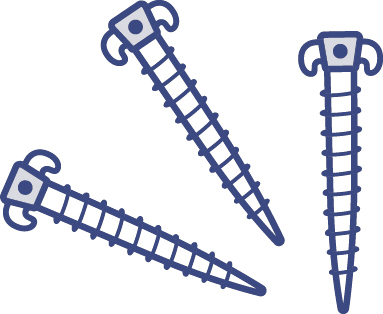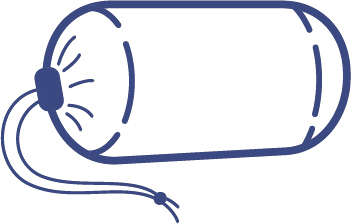NINE
COZY UP: CLOTHING, SHELTER, AND BEDDING
After a Cascadia earthquake, you’ll want to be outside: the strongest feeling of safety will come from having nothing heavy above you that could fall or trap you. But without proper gear, being outside can also be dangerous.
Think of your body as a house with a heater. If all the doors and windows of the house are open and the walls have no insulation, the heater can’t do much. But if you have good insulation and cover areas of major heat loss, the heater will keep the house warm. Proper clothing and shelter allow your body’s natural heating ability to protect you from hypothermia, a condition that can lead to death.
Most people are surprised by the fact that hypothermia can occur when temperatures are in the 50s—and in the Pacific Northwest, average low temperatures are often within that range. Staying warm outside, even in seemingly mild weather, is harder than you might think.
CLOTHING
You need to dress in layers to help your internal heater keep you warm or to be able to cool off when you get too hot. But you need to be careful about what layers you use. You’ll want to plan three layers:
Base layer: fits close to the body but doesn’t restrict movement; underwear and socks are part of this layer, and panty hose or synthetic tights are good for warmth
Second layer: helps insulate your body and keeps you warm; fleece, synthetics, and wool work well here
Outer layer: keeps you dry and helps trap heat near your body; ski pants, rain gear, winter coats, and ponchos are ideal, as well as hats and gloves
You can find clothing at thrift stores or garage sales that meets the requirements for living outdoors. Just be aware that synthetic fabrics can trap odor, so even clean used clothing may not smell fresh. Like many things we’ll adapt to after the earthquake, this might bother you at first but not be noticeable after a few hours.
Wool is the only fabric that can keep you warm even after the fabric is damp. It also has natural fire-retardant properties to help keep you safe from burning debris after the earthquake.
As hikers say, “cotton kills”: it doesn’t help your body retain heat and doesn’t wick moisture away from your skin. In cold and wet conditions, it can make you vulnerable to hypothermia, but in extremely hot temperatures, cotton is the best choice. Light-colored, loose-fitting garments help keep you cool. Straw hats block the sun while letting heat escape from your head.
SHELTER
Your house, condo, or apartment may appear largely undamaged after a mega-earthquake. Even so, many people simply won’t want to be inside their home during a period of frequent aftershocks. Over time, this aversion to being indoors will pass, but it is best to plan for it during the first two weeks.
IS YOUR BUILDING SAFE?
Unless you are trained to assess the safety of structures, it will be hard to know whether you should shelter in your house, condo, or apartment. Frequent aftershocks and unseen damage may mean a structure that looks fine to you could be dangerous to shelter in.
Building codes are calibrated to ensure a building doesn’t collapse during an earthquake, not that it remains usable after the earthquake is over. Don’t assume your house will be safe to live in, even if it was recently constructed.
If you do stay inside your home, consider sleeping under a heavy table so if there is a collapse you will be somewhat protected. Cover openings of broken windows with heavy plastic to keep out wind, rain, and pests.
VEHICLES
A vehicle parked away from anything that could fall on it could be your shelter: crack a window while sleeping to ensure adequate oxygen, and duct-tape fabric over the opening to let air in and keep bugs out. If you have a camper or recreational vehicle, you will be far more comfortable than most of us.
POSITIONING YOUR TENT
Pitch your tent in an open area away from any utility poles or structures that may fall. Trees generally do well during earthquakes, but weak branches may dislodge during aftershocks. Keep away from landslide areas, and make sure to maintain a safe distance from your toilet station. After choosing a site, clear the ground of any sharp objects that may damage your tent.

Ground Cover
Always set up a ground cover or tarp beneath the tent to protect it. Make sure the tarp is a bit smaller than the tent floor perimeter. If it extends beyond this, it will catch condensation from the tent walls and pool it underneath.
Securing the Tent
Follow the directions for securing your particular tent, and check the tent following strong aftershocks.
STORING AND REINFORCING YOUR TENT
Practice pitching your tent until you are familiar with the process and which poles go where. Make sure that tent is 100 percent dry before storing. Ideally, store in a cool, dry place in a mesh bag or large pillowcase so the tent can breathe. If stored in a damp garage or basement, use a sealed plastic bin.

Heavy-Duty Pegs
The pegs that come with your tent may not be strong enough for this situation. Heavier pegs are available through sporting good retailers or online.

Seam Sealer
Seam sealer and repair tape are available to strengthen seams and patch tears. Be sure to buy the right sealant for your tent’s fabric. Gently clean fabric with a rag and rubbing alcohol before making repairs.
STAYING WARM INSIDE YOUR TENT

Extra Layers
Emergency sleeping bags with heat-reflecting Mylar lining can be used inside regular sleeping bags.

Elevation from the Ground
Staying off the ground increases warmth. Any barrier helps—whether a blow-up mattress (with foot pump), yoga mat, foam pad, or even paper-stuffed bags.
TENTS AND TARP SHELTERS
Any open space—a yard, park, or sports field—could be a good place to set up a shelter. Make sure it is away from buildings, utility poles, or other structures that might fall on it. Scout out the best place in the area to locate the twin-bucket system or dig a pit toilet; pitch your tent as far away from this area as you can. Trees generally do well in earthquakes if the soil they live in isn’t subject to liquefaction or slides. However, already weak or diseased branches could be dislodged by strong shaking. Survey your camping spot and move if there are obvious dangers.
Smaller tents or tarp shelters may keep you warmer than larger ones. They also will be easier to transport if you need to evacuate the area you first set up in. Finding a good location for a small tent may be easier than for a large one.
Larger tents have space to stow your supplies. They will allow you to more easily dress, read, eat, and take wet-wipe baths in a sheltered space. You may be able to use cots in a larger tent, keeping you farther from the chill of the ground. A tent housing your whole family may help small children feel more secure than if your family splits up into two or more tents.
Purchasing a Shelter
You could start by purchasing a heavy-duty tarp with grommets and adequate rope or paracord to turn it into an improvised shelter. This means you’ll have at least something. The tarp can serve as a ground cover under a tent if or when you later buy one.
Used tents cost a fraction of what you’ll pay for a new one. Check garage sales, sporting goods consignment stores, Craigslist, and Buy Nothing groups. Remember, it’s only a bargain if the tent will keep you dry, so check for problems before you buy. Any tent will benefit from applying seam sealer to help ensure it stays waterproof. Serious campers recommend replacing the included tent pegs with a set of heavier ones from a sporting goods store or online.
There won’t be a perfect choice; the best tent for an August heat wave is unlikely to work as well in a January snowstorm. Any shelter you have on hand after the earthquake will be better than having nothing. If you have the right clothing to keep you warm or cool, your shelter only needs to keep you dry and supply a bit of privacy.
If you don’t hike, camp, or hunt, you may have never pitched a tent. The middle of the night after an earthquake is a poor time to learn this skill. You should choose a tent that is designed for easy setup. Take it out of the box and make sure it is easy for you—or practice until it is.
BEDDING
If you can’t stay warm, you won’t sleep well—which, as discussed in Chapter Seven (this page), can put you at risk when you need to think clearly in a dangerous situation.
Sleeping bag temperature ratings are based on whether the bag can keep you from freezing at the specified temperature, not whether you’ll be comfortable enough to sleep. Don’t breezily believe that you’ll be sleeping snug in a bag rated for 30 degrees F when it’s 35 degrees F outside.
Many of us have sleeping bags that are well suited to living-room slumber parties and summer camping but worthless for keeping us warm in cold weather. Bags that perform well at low temperatures are expensive; those that are also lightweight are more expensive still.
One way to save money is by getting emergency sleeping bags with a heat-reflecting Mylar lining. They cost $10 to $15 and can be used as a liner inside a regular sleeping bag to increase warmth. They are small and easily stored, and they can be used alone if that is all you have. However, they aren’t designed for long-term use, so one Mylar bag might not make it through the first two weeks post-earthquake. Duct tape can mend small tears, but having extra Mylar bags may also make sense.
In the days before sleeping bags, people kept warm with layered wool blankets and quilts. Wool is the only material that can insulate even when damp, making it a clear choice for staying warm. Used wool blankets often cost $10 to $80; new ones can be $100 to $300. Heavy all-wool coats in large adult sizes, which often cost under $10 at thrift shops or garage sales, could work to cover children. If you cut it and stitch it to create a large, flat surface, the coat will be less likely to slip off as a blanket. Generally, cotton quilts and blankets should not be used when sheltering outside in damp weather, for the same reason cotton clothing makes it harder to stay warm.
Staying off the ground will keep you warmer. A blow-up mattress with a foot pump will do; one that needs electricity to inflate it will be worthless. Expensive and comfortable self-inflating camping pads are excellent. Cheap and less comfortable foam pads (think exercise and yoga mats) also work. Even two contractor-weight garbage bags, stuffed tightly with balls of wadded paper (newspaper, packing paper, book pages) or fabric and duct-taped together, will work as a ground pad.
CLOTHING AND SHELTER CHECKLIST
CLOTHING: NECESSARY PER PERSON
□ Base-layer top of synthetic fabric (like polypropylene) or wool; avoid cotton, cotton-poly blends, rayon, Tencel, bamboo, and hemp
□ Base-layer bottom of fabric similar to top
□ Second-layer top of polar fleece or synthetic vest
□ Second-layer pants of wool or synthetic material; avoid denim jeans!
□ Outer-layer coat—a two-part jacket with inner insulating layer and outer wind- and waterproof layer is ideal; a wool coat with a sturdy waterproof poncho over it can be a do-it-yourself version
□ Outer-layer pants—light waterproof pants or ski pants or ski overalls
□ Wool hat or ski hat
□ Wool gloves with fingers that fold back
□ Wool socks or synthetic socks made for cold-weather sports
□ Sturdy shoes
□ Loose-fitting light-colored cotton garments
□ Cotton socks
□ Underwear
CLOTHING: NICE TO HAVE PER PERSON
□ Balaclava or neck gaiter
□ Silk or wool scarf
□ Straw sun hat
□ Sturdy, handheld folding paper fan
□ Hot-weather garments with built-in sun protection
□ Weatherproof covers for shoes (like vintage galoshes)
SHELTER: NECESSARY
□ Tent (seam sealed), tarp, or vehicle
□ Paracord or rope
□ Tent patching kit or heavy-duty waterproof tape
SHELTER: NICE TO HAVE
□ Rolls of heavy plastic sheeting or used or new shower curtains—to cover openings of broken windows
□ Staple gun or tack hammer—to secure plastic over window openings
□ Waterproof duct tape—to patch leaks
□ Tarp—to put under tent
□ Extra tent peg kit with heavy pegs
BEDDING: NECESSARY PER PERSON
□ Sleeping bag—the best you can afford for cold weather
□ Mylar sleeping bag—as a liner for extra warmth if you don’t have a cold-weather sleeping bag
□ Ground pad